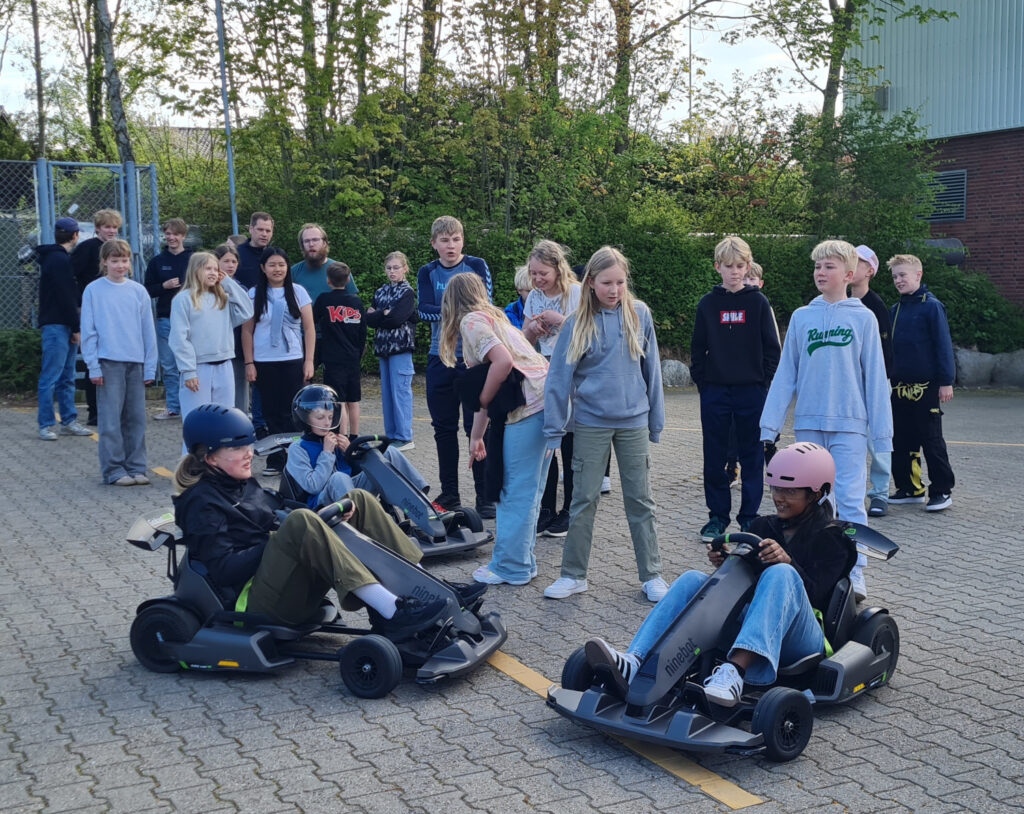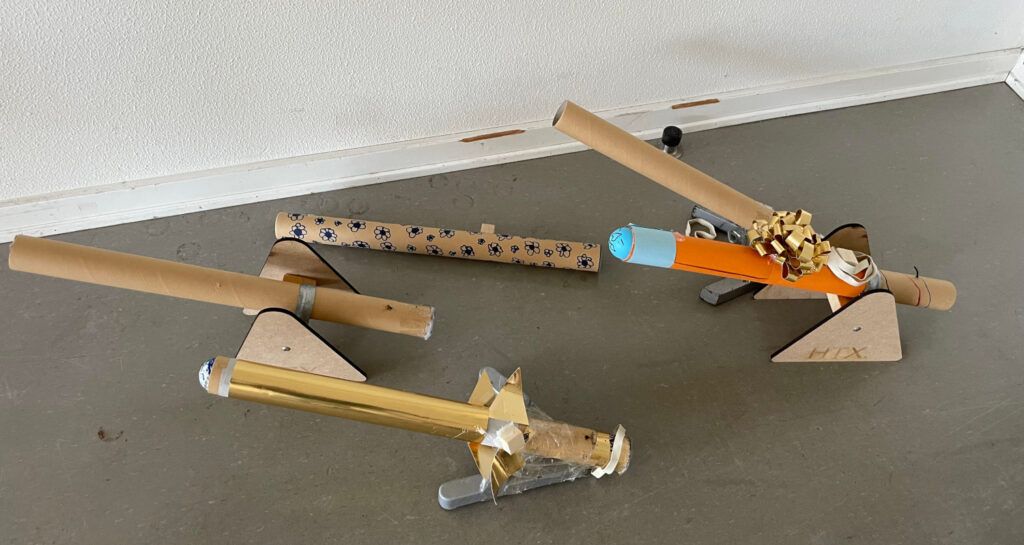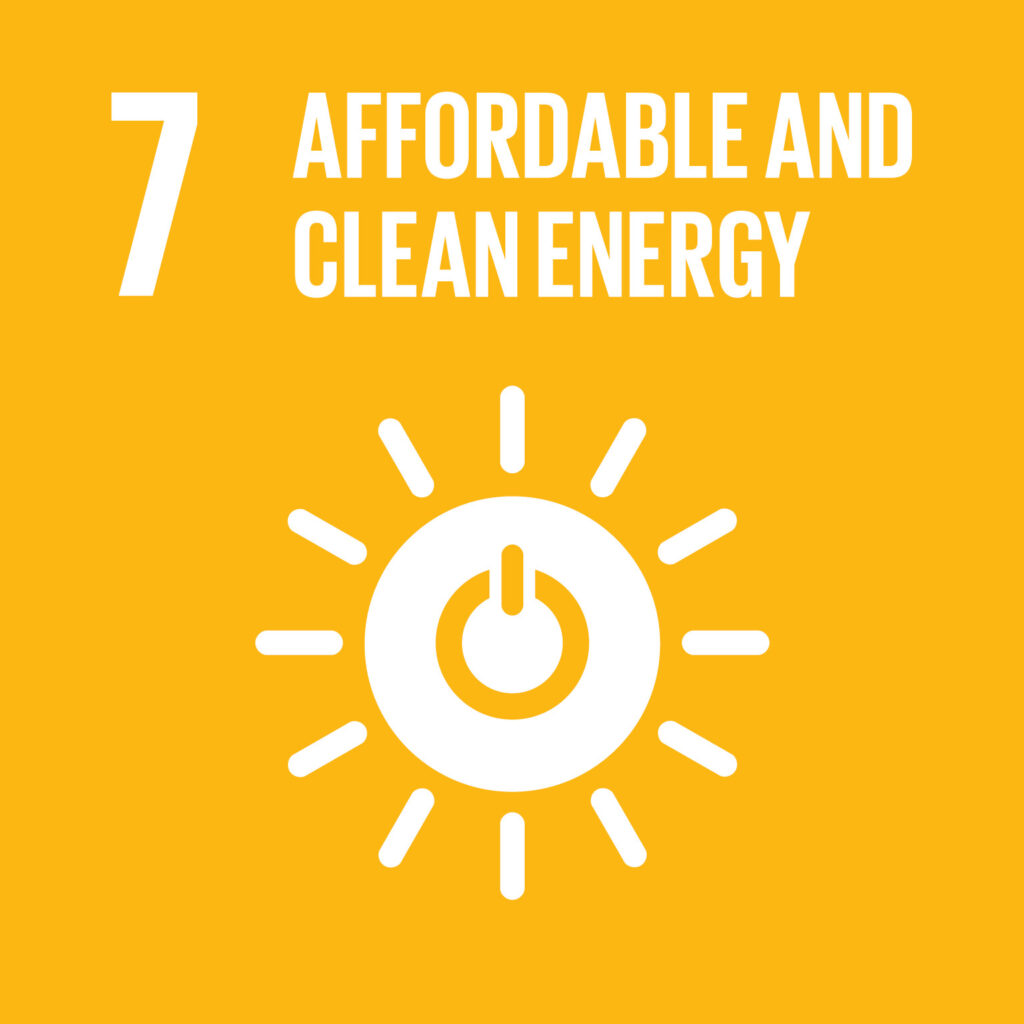DK HTX Svendborg & Haahrs “Electric Go-Karts and Kinematics”
The teaching module was conducted with electric Go-Karts at Technical Highschool Svendborg (HTX), 3rd May and 13th May 2024.
4 Students from grade 12 (HTX, 2.g) trained and supported 28 pupils (15 girls, 13 boys) from a 5th-grade class at Haahrs during the module. The same module was applied to grade 7-class from the same school.
The teaching module was conducted with electric Go-Karts at Technical Highschool Svendborg (HTX), 3rd May and 13th May 2024.
4 Students from grade 12 (HTX, 2.g) trained and supported 28 pupils (15 girls, 13 boys) from a 5th-grade class at Haahrs during the module. The same module was applied to grade 7-class from the same school.
Teaching Design
Learning objectives The cooperation between teachers from HTX and Haahrs was intended to introduce the pupils to new technologies and to make them communicate their learning processes. The HTX students would practice their communication skills, while the elementary students would engage with technology and sustainability.
Students’ co-influence
All pupils were actively involved in the module, working with video analyses and driving techniques. The HTX students had signed up voluntarily as tutors to instruct the pupils in performing video analyses and essential methods for measuring speed.
Content and activities
– The role of electric cars in the green transition, energy chains and energy conversion.
– Basic kinematics: measurement of velocity, acceleration, braking distances, and force ratios.
– Determination of the speed of cannonballs (ping pong balls).
First day: 6.5 hours, level-crossing teaching and learning activities. Second day: Finalization of data at own school. Third day: Level-crossing evaluations.
First day:
1) Collective brainstorming session to gather keywords and concepts.
2) Following this, students created drawings illustrating energy conversion from the source to the end.
3) Each group presented briefly their energy chain and the pros and cons of electric cars.
4) Practice: The pupils drove the go-karts, each taking a single lap. Methods for calculating velocity were taught between two points, with students working on examples supported by the HTX students.
5) The pupils sat up cones, measured distances, and took turns driving while their group members recorded the process.
6) The data were processed to determine the speed development. Using student input, the acceleration was identifed, and the braking distances were measured from 3 different speeds, with group members recording the data. HTX students provided instructions and guidance throughout the process.
7) The results were discussed in a plenary session. The pupils saved important data for further processing at their school.
Students’ learning products: Video analyses in Logger Pro.
Pedagogical methods, play methods The module operated with a strongly practice-based and practice-related approach. The teacher took advantage from playground methods, promoting the pupils´ motivation and personal engagement.
HTX students acted as learning consultants throughout the entire process, guiding and assisting the groups of younger pupils.
Evaluations
The teachers agreed upon having reached the goals, though students to a certain degree seemed having been focused mostly on the driving itself. However, the pupils had fullfilled their learning tasks and achieved the learning objectives; maintaining focus better than expected by the teachers.
The HTX students effectively conveyed information. This experience provided valuable training for the HTX students in communication. The 5th-grade students seemed attentive to their older peers and expressed their eagerness to return. Thus, Haahrs recommended repeating the module with future 5th graders.
The go-karts offered an exciting way to introduce concepts of the green transition, avoiding long lectures and introducing engaging play.

The role of electric cars in the green transition involves understanding how these vehicles contribute to reducing carbon emissions and reliance on fossil fuels. Central to this transition is the concept of energy chains and energy conversion, where electric cars utilize electricity, often from renewable sources, to power their engines, thereby reducing pollution.
Basic kinematics is crucial for understanding the performance and safety of electric cars.
This includes measuring key factors such as velocity, acceleration, braking distances, and force ratios. These measurements are essential for assessing the efficiency and effectiveness of electric vehicles in real-world conditions, ensuring they meet both performance and safety standards.
Pupils´ learning products
The pupils undertook video-analyses of their races.

Extension
Another version of this module has been conducted with 7th-grade pupils from Haahrs, extended with calculations of bullet lanes of cannons. For experimental purposes, the students created their own “cannons”.

Digital production
The technologies chosen were Excel and Logger Pro for handling the data from the go-karts and the cameras. Apart from that, the students used their own smartphones for data collection.
The methods applied during the short module encompassed firstly introductions with simple instructions and secondly own exploration of the technologies. Thirdly, the students sorted, calculated and concluded on the technical data, which they had both created and collected.
Retrospective reflection Students worked on understanding energy chains and how energy is converted from one form to another. They explored the significance of electric cars for green transport and the green transition. They studied basic kinematics, including concepts like velocity, acceleration, and forces. Additionally, they learned and practiced driving techniques to optimize lap times in a race.
Digital literacy
The students engaged in energy conversion, green transport, and kinematics as a promotion of ethical and socially beneficial awareness in education context. Well-educated students are fundamental for encouraging a responsible use of resources, benefiting both the societies and the planet.
In addition, the module addressed the students´ critical thinking by discussing the pros and cons of electric transportation.
The students gained experience with using advanced technologies, and they learnt how to use their own smartphones for data collection. Thus, the module became individually relevant for them.
Environment
The exchange of ideas and methods with teachers from RBZ Wirtschaft in Kiel, had resulted in new methods for communicating across different educational levels. Thus, the HTX teacher and the Haahrs teacher collaborated closely during the preparatory phase in this part of the ´education chain´. The actual learning processes across educational levels involved 5th-grade students and 2nd-year students (grade 12), fostering teacher-student collaboration and peer tutoring, all of it management-supported from both schools.
Inspiration for this module emerged from cross-national collaboration in MYRE DK-DE and dialogues among the teachers in the project.
The goal of the module was to awaken the pupils´ interest in natural science and technologies, and to decrease their negative expectations to this field. As students are opting out of these STEM subjects in Denmark, it is important to attract more young people into the field and stimulate their educational choices via career learning.
The module related to digitalization in society. It aligned with global trends towards green transport and concretely related to the UN Sustainable Development Goals for energy efficiency and education in STEM fields.
The role of electric cars involves understanding how these vehicles contribute to reducing carbon emissions and reliance on fossil fuels. Central to this transition is the concept of energy chains and energy conversion, where electric cars utilize electricity, often from renewable sources, to power their engines, thereby reducing pollution.
For the future, collaboration with companies can be imagined to explore the added value of the new technologies for business purposes.
Det er meget sjovt at bruge det man har lært i timerne i virkeligheden. Og at lære det videre!
Jeg har selv været i brobygning og kan godt lide at give videre til elevr der kommer her hvordan det er at være gymnasieelev.
Jeg synes det er meget fint at få repeteret og videregive det, eleverne kan forvente at få her.Student, HTX Svendborg

MYRE DK-DE has received financial support from PKP | Interreg Deutschland – Danmark.
In addition to the 35% co-financing, the three project partners have contributed significant own resources and engaged a wide range of network partners.




